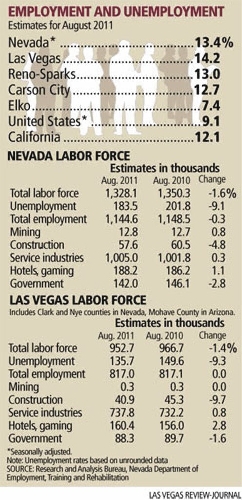Unemployment up for fourth straight month in Las Vegas
The newest unemployment numbers don't even begin to describe how bad the jobs outlook is for many Nevadans.
The local jobless rate jumped to 14.2 percent in August, while the state's rate ticked up to 13.4 percent, the Department of Employment, Training and Rehabilitation reported Friday. In all, 183,500 people, including 135,700 Las Vegans, were out of work in Nevada.
Worse still, in the 12 months ending in August, half of Nevada's jobless were long-term unemployed -- out of work for 26 weeks or more. Those workers face a cycle of deteriorating skills resulting in even worse hiring prospects.
"The concern is that the longer one is without a job, the more likely it is that his or her skills will erode, and they will lose some of their competitiveness once the labor market recovers," state economist Bill Anderson said.
Breaking the spiral requires knowing who the persistently jobless are and the structural economic issues that encourage sustained joblessness. But the U.S. Bureau of Labor Statistics, which collects jobless data, doesn't track long-term unemployment by demographics.
Anecdotally, employment experts say Southern Nevada's long time jobless are mostly service workers older than 50, with a high school diploma or less. They're concentrated in hard-hit, low-skilled sectors such as construction and leisure and hospitality. Southern Nevada in August had 14,500 fewer leisure sector jobs and 71,000 fewer construction positions than it had in its boom era.
No jobs, can't afford to leave
Several structural problems are holding back the perennially jobless. Contrary to popular belief, they're not staying out of the workforce because they have extended unemployment benefits, said Bill Werksman, of Las Vegas placement firm Resource Partners.
Simply put: There are no jobs here, and they can't afford to leave.
"The problem is, in this particular economy, we don't have anywhere else for people to go," Werksman said. "Go 30 miles outside town, and you're in the desert. So they remain unemployed until they can switch careers, wait out the recovery or move."
But moving isn't practical. Past recessions had regions that enjoyed good times. Today, nobody's building much of anything anywhere.
Even if construction picked up nationwide, many local long-term jobless are tethered by homes and families, said Jeff Waddoups, a labor economist at the University of Nevada, Las Vegas.
"They have a house with a mortgage that's under water, and they have family ties. Those things increase the cost of leaving," Waddoups said.
Nor is entrepreneurship a big option. Sure, new business filings with the Nevada secretary of state have risen the past two quarters, indicating growing interest in going solo, said Brian Gordon, a principal with the Applied Analysis research firm. Today's long-term jobless face startup barriers, though.
"A lot of these people worked in jobs that they considered very steady, and they can be risk-averse," Werksman said. "Did anyone think the real estate market would crash and construction would dry up? They always thought they would be secure. Now, they have to get out there. Being an entrepreneur takes capital, too, and they may not have it."
Given those structural problems and little demand for new resorts, homes and offices, the outlook for the long-term jobless is "dim," Werksman said.
"Their prospects are pretty grim," Waddoups agreed. "Unless something big starts to happen, I don't see that there's too much work for them ."
What could be done
It'll take a combination of approaches to fix the situation.
Waddoups suggested increased public spending on building renovation and infrastructure while financing is cheap.
"It's hard to imagine there aren't some projects that don't warrant borrowing at 2 percent to get a higher return in the future," he said. "We have idle equipment and idle workers. Why not pull some work from the future and put it in the present, where it's needed?"
Waddoups also likes the idea of making workers more mobile, working with banks on mortgage relief for underwater homeowners.
Retraining programs might also help. The best job growth in Southern Nevada probably will come in nontraditional areas such as health care, business services and renewable energy, Anderson said.
Others say the only long-term solution is to let the downturn run its course.
Werksman said he doesn't see public money for initiatives such as mortgage relief. Also, there is evidence the market is slowly righting itself.
Through the first eight months of 2011, employment fell 0.2 percent statewide, for a loss of 2,000 jobs. Compare that with the 9.1 percent drop in 2009, when the state shed 115,000 positions.
"Market conditions generally tend to work themselves out," Gordon said. "Unfortunately, that can be over the long term. At some point, investment in office, industrial, retail and residential projects will occur, but it will be measured in years, and not months. This is not necessarily a positive for those sitting on the sidelines today, but long-term prospects for the economy remain bright."
Contact Jennifer Robison at 380-4512 or jrobison@ reviewjournal.com




























